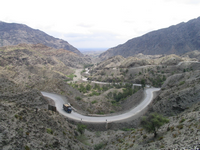Recent news reports indicate that the Obama administration is having second thoughts about whether it wants to double the size of the U.S. military presence in Afghanistan. The president has directed the Pentagon to think very clearly about the specific strategy and purposes involved with any troop increase. Independent defense experts continue to debate the wisdom of applying a variant of the troop surge policy that has apparently stabilized the security situation in Iraq to Afghanistan, with its very different local conditions. One weighty constraint on the proposed force increases concerns logistics. Recent developments in Pakistan and Central Asia in particular have led American military planners to worry about their ability to support a much larger force, with its very sophisticated (and therefore extremely high-maintenance) equipment, in such a logistically challenging theater of operations as Afghanistan. The United States would have to drastically increase its deliveries of food, fuel, munitions, and construction materials to this remote, mountainous, landlocked country. At present, the main route for delivering bulk supplies to American and NATO forces in Afghanistan extends over 800 miles from Karachi (Pakistan's largest port), to Peshawar (a major shipping center in northwestern Pakistan), through the tortuous 1,000-meter high Khyber Pass to the Pakistan-Afghan border crossing at Torkham. NATO hires private contractors to carry cargo on trucks and other vehicles. These entrepreneurs convey approximately three-quarters of the food, fuel, munitions, and other non-vital supplies consumed by American, ISAF and other Western troops in Afghanistan.
Global Insights: Do All Roads Lead to Afghanistan?

